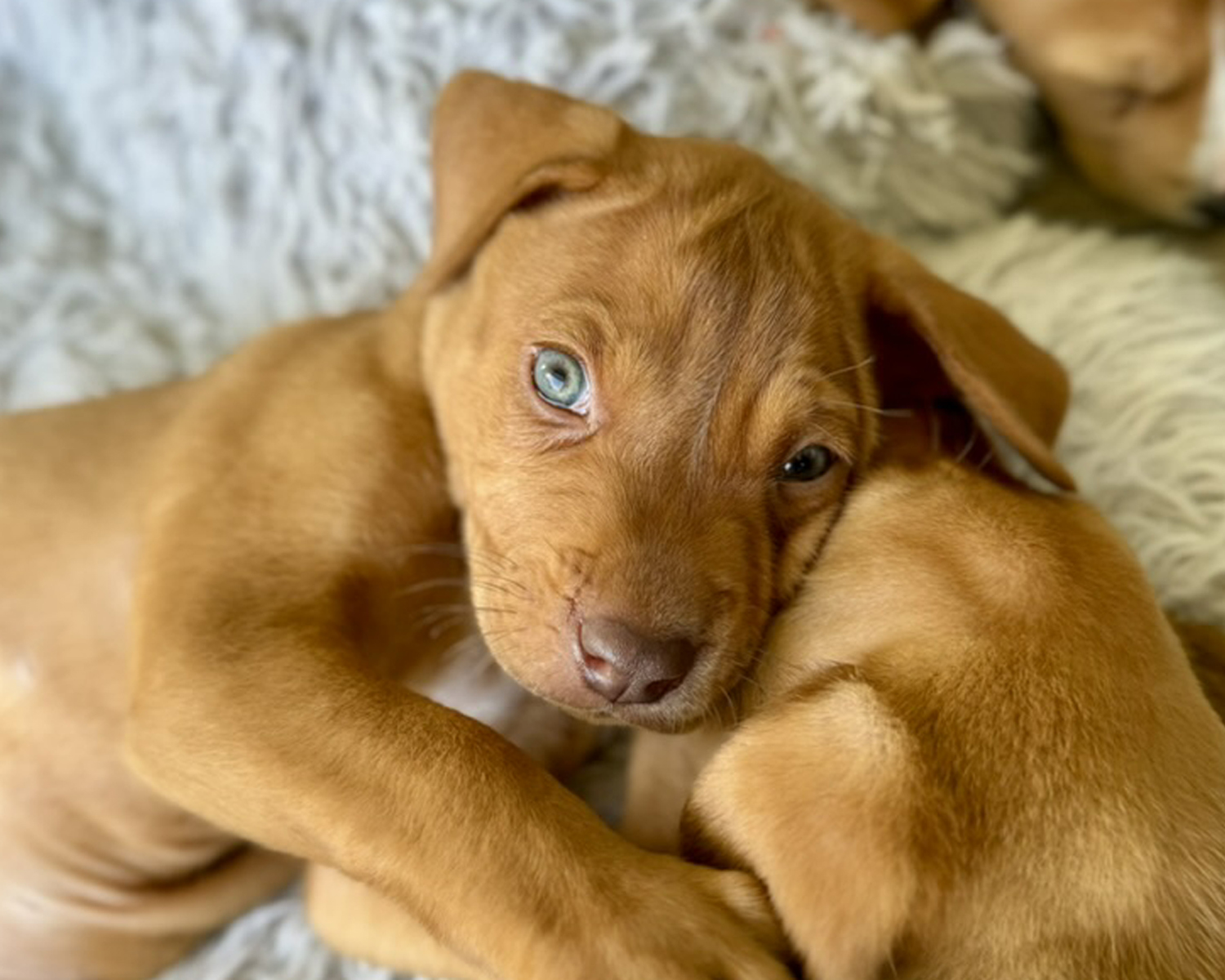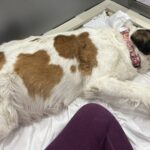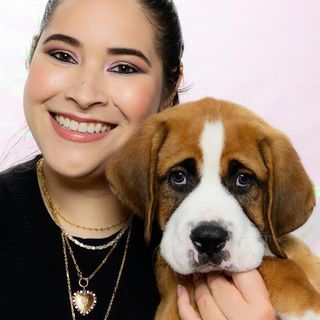While it can be time-consuming and daunting at first glance, establishing sanitation procedures and protocols is critical to better-protecting the health of all animals housed within a shelter or rescue, especially those more vulnerable populations (like sick, elderly, and/or young residents). Ideally, the rescue should have information about what areas and surfaces need to be sanitized with how often and with what product(s).
Sanitation typically involves four steps: mechanically removing organic material, using a detergent to get the surface visibly clean, applying a disinfectant to kill pathogens, and drying the area.1 The first two steps are often part of cleaning, while disinfecting requires application of a specific type of product necessary to inactivate pathogens and is what will mitigate the spread of infectious disease. It’s important to do both and to recognize what needs to be thoroughly cleaned and disinfected.2
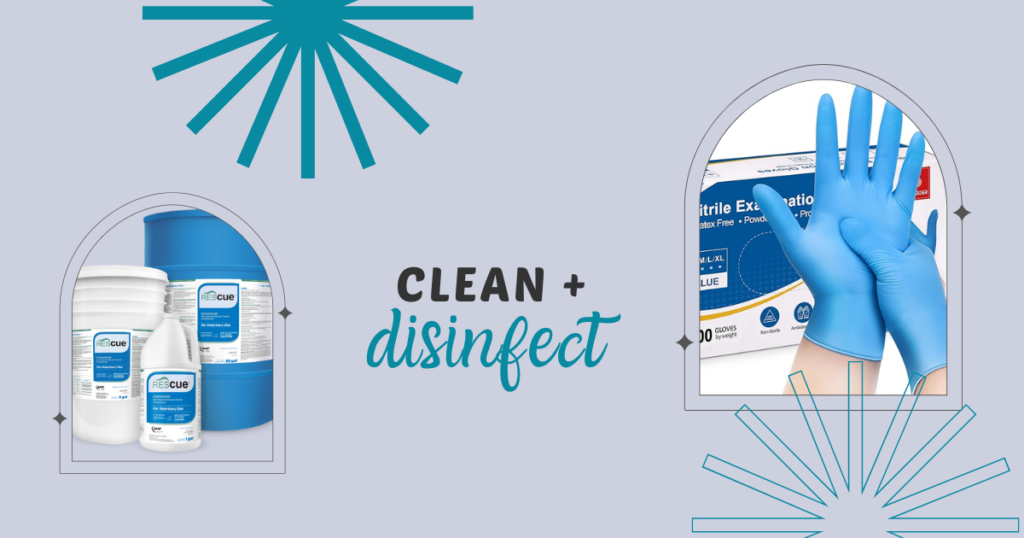
Recommended Areas to Sanitize
In general, you want to thoroughly sanitize (that means cleaning AND disinfecting) high-traffic or high-contact areas or any areas where multiple animals may come through, especially new intakes or known sick animals, as they carry higher-risk of disease transmission. It is also important to pay attention to any areas where more vulnerable populations will be in as well.3
Low-traffic areas can often be categorized as low-contact or low-risk and can be cleaned regularly but disinfected as needed, while areas and objects that do not come into contact with people or animals can be cleaned and disinfected as needed.4 These types of areas may include storage rooms and offices but only if animals are not allowed in these spaces.
| Area | Category | Protocol | Frequency |
|---|---|---|---|
| Main Entrance | High-traffic/high-contact | Clean + Disinfect regularly | Floor, doors, handles, signage, chairs, tables, other high-touch points should be disinfected throughout business hours if open to the public/volunteers; at least once at the end of each business day |
| Lobby | High-traffic/high-contact | Clean + Disinfect regularly | Floor, doors, handles, signage, counters, desks, tablets, credit card machines, chairs, tables, other high-touch points should be disinfected throughout business hours if open to the public/volunteers; at least once at the end of each business day |
| Offices (allowing animals) | High-traffic/high-contact | Clean + Disinfect regularly | Doors, handles, signage, chairs, tables, keyboards, mice, and other high-touch points should be disinfected at least once at the end of each business day if animal(s) were present |
| Offices (prohibiting animals) | Low-risk | Clean regularly, disinfect as needed | Appliances, computers, technology, desks, tables, chairs can be cleaned once or twice a week; disinfect high-contact surfaces like door handles, phones, etc. three to four times a week (or more often) |
| Storage Room | Low-risk | Clean regularly, disinfect as needed | Floor and shelves cleaned weekly or bi-weekly; high; disinfect high-contact surfaces like door handles as needed |
| Hallways | High-traffic/high-contact | Clean + Disinfect regularly | Floor, door handles, and other high-contact surfaces should be cleaned and disinfected at the close of each business day |
| Play Yard | High-traffic/high-contact | Clean + Disinfect regularly | Clean and disinfect at least once a day, if not more frequency depending on usage; pick up organic debris between uses; do not mix healthy and sick animals in the space |
| Laundry | High-traffic/high-contact | Clean + Disinfect regularly | Clean and disinfect all surfaces daily, plus in-between loads if dirty laundry touches floor, exteriors of laundry appliances, etc. |
| Intake Room | High-contact/high-risk | Clean + Disinfect after each intake | Clean and disinfect all surfaces and equipment thoroughly after each intake; anything that cannot be disinfected should be discarded. |
| Examination or Medical Room | High-contact/high-risk | Clean + Disinfect after each animal | Clean and disinfect all surfaces and equipment thoroughly after each animal; anything that cannot be disinfected should be discarded. |
| Quarantine (or Isolation) Kennel | High-risk | Clean + Disinfect regularly | Clean and disinfect all surfaces and equipment daily. Animal MUST BE removed before deep cleaning. |
| Kennels | High-risk | Clean + Disinfect regularly | If the kennel houses the same animal: clean regularly of debris/organic material, deep clean (clean and disinfect) at least once every two weeks OR if heavily soiled OR if animal has been exposed to or has n infectious disease.5 Animal MUST BE removed before deep cleaning. Clean and disinfect after an animal leaves a kennel and it is expected that a different animal will occupy it. |
| Transportation Vehicle | High-risk | Clean + Disinfect regularly | Clean and disinfect all surfaces and equipment thoroughly after each transport; anything that cannot be disinfected should be discarded. |
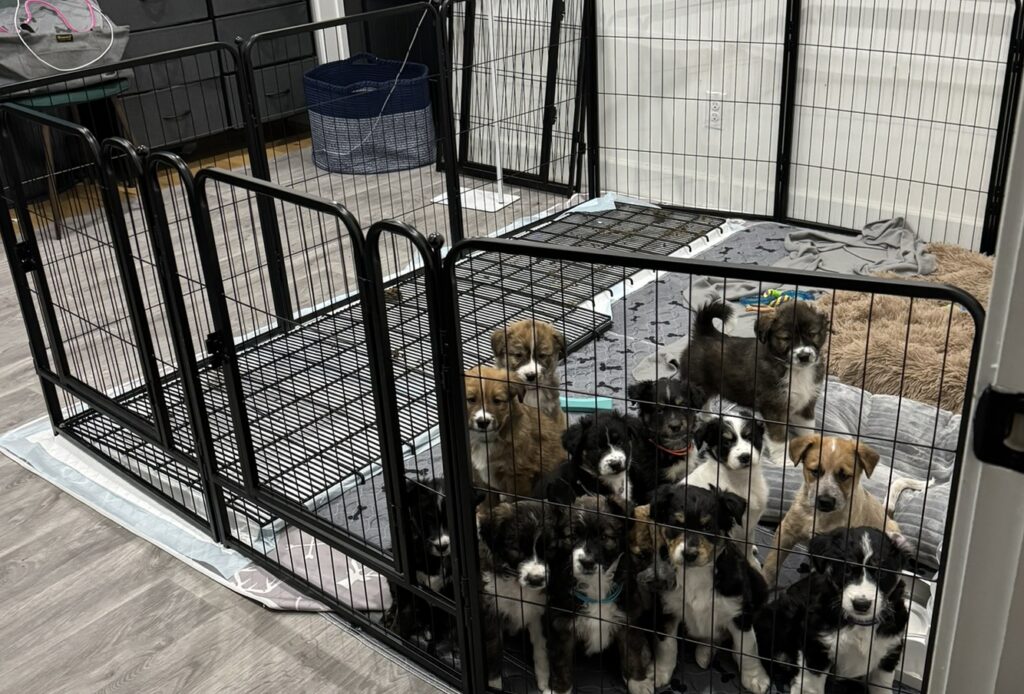
Recommended Objects to Sanitize
The table below is a non-exhaustive list of common objects found in rescues and shelters that should also be cleaned and/or disinfected regularly.
| Object | Category | Protocol | Frequency |
|---|---|---|---|
| Carriers/crates | High-contact/high-risk | Clean + Disinfect between animals | Clean and disinfect thoroughly between animals; if used by the same animal over and over, once weekly |
| Gates/pens | High-contact/high-risk | Clean + Disinfect between animals | Clean and disinfect thoroughly between animals; if used by the same animal over and over, once weekly |
| Bedding | High-contact/high-risk | Clean + Disinfect between animals | Clean and disinfect thoroughly between animals or if soiled; if used by the same animal over and over, once weekly |
| Food/Water bowls | High-risk | Clean + Disinfect regularly | Clean and disinfect thoroughly between animals or if soiled; if used by the same animal over and over, once weekly |
| Grooming Tools | High-contact/high-risk | Clean + Disinfect after each use | Clean and disinfect after each use unless residing in the same animal’s kennel, then only before putting back into supply area |
| Toys | High-contact/high-risk | Clean + Disinfect regularly | Clean and disinfect after each use unless residing in the same animal’s kennel, then only before putting back into supply area |
| Cleaning tools | High-contact/high-risk | Clean + Disinfect regularly | Clean and disinfect in-between |
| Clothing | High-contact/potentially high-risk | Wear PPE if handling intake, quarantined, or sick animals | Staff and volunteers should handle animals from most vulnerable to least vulnerable and healthiest to least healthy. Appropriate PPE should be worn when intaking new animals and when working with sick animals. |
| Shoes | High-contact/high-risk | Wear disposable or reusable booties | Staff and volunteers should wear disposable or reusable booties when walking on surfaces where vulnerable populations go (like play yards, their individual kennels, intake rooms), like puppies, unvaccinated animals, etc. |
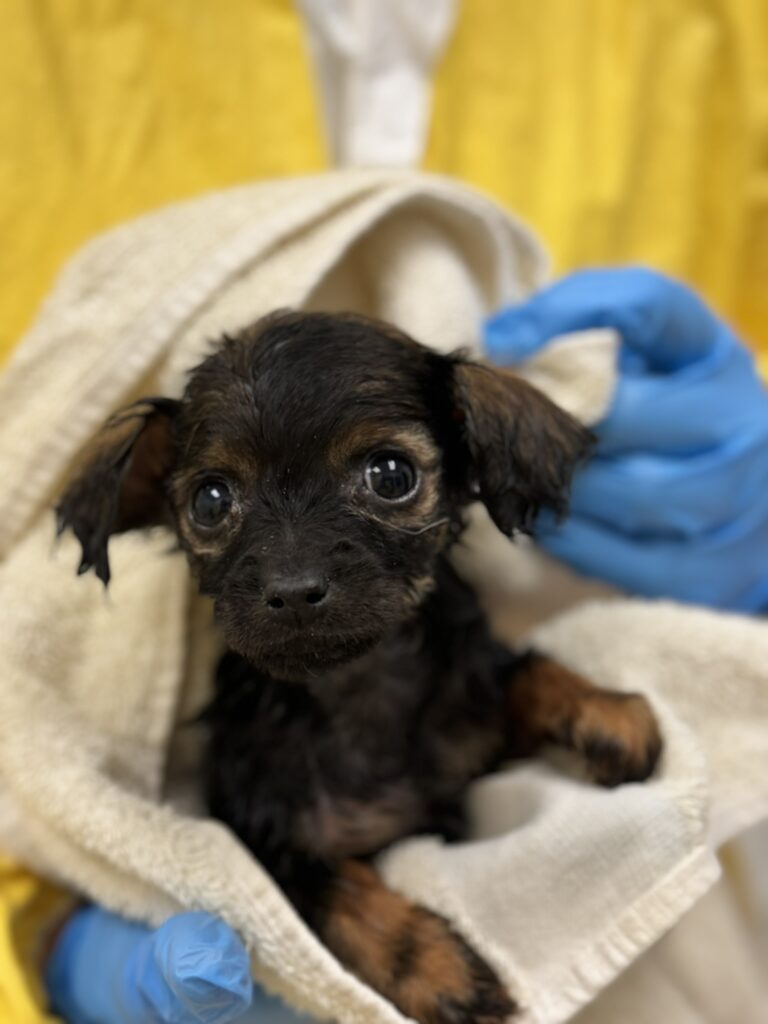
Hand Sanitization in the Shelter Environment
I cannot stress the importance of ensuring staff, volunteers, and visitors regularly wash their hands as they move from one area to the next, as this will help ensure areas that animals aren’t typically in will stay low-risk. The more compliant people are, the less likely they are to contaminate high-contact touch points throughout the rescue, which helps to lower the risk of disease transmission.
People can wash their hands for 20 seconds using soap and water, making sure to get underneath fingernails and washing up to forearms, then completely dried if hands have come into contact with bodily fluids, are greasy, etc.6
Hand sanitizer (must contain at least 60% isopropyl alcohol) can be used if there is no dirt/debris on hands that would require mechanical cleaning.5 People should wear disposable gloves when handling animals with unknown health status or have or are suspected of having a spreadable illness.5
Use Disposable and Reusable Booties over Foot Baths
Both University of Wisconsin, School of Veterinary Medicine – Shelter Medicine and ASPCA Pro recommend AGAINST using foot baths as a means to minimizing contamination via shoes and footwear. Disinfectants must come into contact with the shoe’s surface for a specific length of time (as long as 10 minutes), and many disinfectants have reduced effectiveness if they come into contact with organic matter.7
If using a foot bath, the disinfectant must be chosen wisely; peroxygen compound disinfectants are still effective in the face of organic matter and showed 67% to 78% reduction in bacterial concentrations (after boots were soaked for SEVEN! minutes), while quaternary ammonium compound disinfectants showed no significant reduction.8 The foot bath must be deep enough to cover the tread of most footwear, and all people using it need to know how long to stand there in the foot bath before drying their shoes off. The foot bath should be changed at least once daily, if not more often, depending traffic levels and by contamination by organic matter.
There are plastic, disposable booties for use in highly-contagious areas (such as intake rooms, isolation/quarantine kennels, etc.), reusable, cloth booties that can be laundered between uses or between kennels, or rubber over-shoes that are easy to disinfect and very durable/impenetrable. These slip over existing shoes and eliminate the need for foot baths.
Disinfectant Effectiveness Chart
Peroxygen compounds are considered the newest and “better” of available disinfectants for their efficacy, shorter contact time, and being more friendly to animals and the environment.9 The name brand often used here is Rescue, which is available in concentrate (most cost-effective) and ready-to-use (liquid and in wipes), which doesn’t require dilution and works faster.
Newer quaternary ammonium compounds (QAC) are more effective than the original QAC at killing some enveloped and nonenveloped viruses. Unfortunately, independent studies have not been able to show that QACs are effective against things like parvovirus.10
Below, find a list of common disinfectants for shelter and rescue use and what they’re effective against, necessary contact time, whether they’re inactivated by organic debris/material, and whether they need to be rinsed after applying.
| Brand | Disinfectant | Effective Against | Contact Time | Inactivated by Organic Debris | Rinse Required? |
|---|---|---|---|---|---|
| Rescue | Accelerated hydrogen peroxide | adenovirus (hepatitis) Bordetella E. coli Parvovirus Influenza A Distemper Salmonella Mycoplasma Ringworm staphylococcus | Bactericidal/fungicidal – 5 minutes at 1:16 dilution Virucidal – 5 minutes at 1:16 to 1:64 dilution; 10 minutes for parvovirus Contact surface sanitizer – 3 minutes at 1:128 dilution | Minimally | No |
| Virkon | Potassium peroxymonosulfate | Adenovirus (hepatitis) Bordetella E. coli Parainfluenza Parvovirus Distemper Mycoplasma Ringworm Staphylococcus | 1% for 10 minutes for viruses, including parvovirus 2% for 10 minutes for ringworm | Slight | No |
| Clorox Bleach | Sodium hypochlorite | Adenovirus Bordetella Distemper Parainfluenza Parvovirus Ringworm Salmonella | 1:32 dilution for 10 minutes | Yes | Yes |
| Wysiwash | Calcium hypochlorite | Distemper Giardia Leptospira Listeria Parvovirus Salmonella Streptococcus Staphylococcus | 10 minutes | Yes | Yes |
| Roccal | Quaternary ammonium compounds | Giardia Leptospira Listeria Salmonella Streptococcus Staphylococcus | 10 minutes | Moderately | Yes |
Footnotes
- Shelter Medicine – UW–Madison. (n.d.-c). https://sheltermedicine.wisc.edu/library/resources/disinfectant-for-animal-shelter ↩︎
- Sanitation in Animal Shelters. (n.d.). Koret Shelter Medicine Program. https://www.sheltermedicine.com/library/resources/sanitation-in-animal-shelters#cleaned ↩︎
- Disease Control – The Role of Sanitation Training Playbook | Network Partners. (n.d.). Best Friends Animal Society. https://network.bestfriends.org/education/manuals-handbooks-playbooks/disease-control-role-sanitation-training-playbook ↩︎
- Disease Control – The Role of Sanitation Training Playbook | Network Partners. (n.d.-b). Best Friends Animal Society. https://network.bestfriends.org/education/manuals-handbooks-playbooks/disease-control-role-sanitation-training-playbook ↩︎
- Dog Enclosure Sanitation. (n.d.). ASPCA PRO. https://www.aspcapro.org/sites/default/files/2022-11/aspca-dog-enclosure-deep.pdf ↩︎
- Hand Sanitation in an Animal Shelter. (n.d.-b). Koret Shelter Medicine Program. https://www.sheltermedicine.com/library/resources/hand-sanitation-in-an-animal-shelter ↩︎
- Sanitation in Animal Shelters: foot sanitation. (n.d.-c). Koret Shelter Medicine Program. https://www.sheltermedicine.com/library/resources/sanitation-in-animal-shelters#Foot%20sani ↩︎
- Morley, P. S., Morris, S. N., Hyatt, D. R., & Van Metre, D. C. (2005). Evaluation of the efficacy of disinfectant footbaths as used in veterinary hospitals. Journal of the American Veterinary Medical Association, 226(12), 2053–2058. https://doi.org/10.2460/javma.2005.226.2053 ↩︎
- Ingraham, A., & Fleischer, T. M. (2003). Disinfectants in laboratory animal science: what are they and who says they work?. Lab animal, 32(1), 36–40. https://doi.org/10.1038/laban0103-36 ↩︎
- Shelter Medicine – UW–Madison. (n.d.-d). https://sheltermedicine.wisc.edu/library/resources/polyhexanide-and-quaternary-ammonium-compounds-qac-as-disinfectants-in-a-shelter-setting ↩︎

